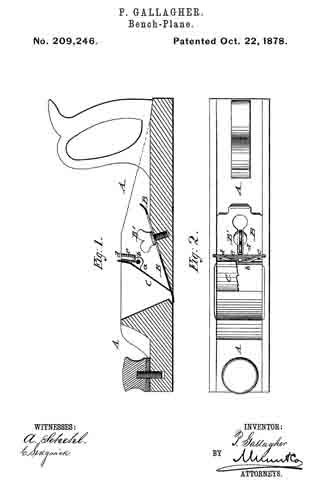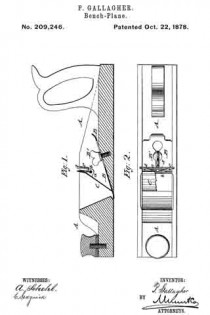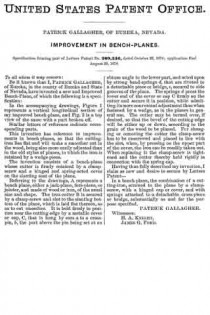No. 209,246 – Improvement In Bench Planes (Patrick Gallagher) (1878)

UNITED STATES PATENT OFFICE.
_________________
PATRICK GALLAGHER, OF EUREKA, NEVADA.
IMPROVEMENT IN BENCH-PLANES.
_________________
Specification forming part of Letters Patent No. 209,246, dated October 22, 1878; application filed August 29, 1878.
_________________
To all whom it may concern:
Be it known that I, PATRICK GALLAGHER, of Eureka, in the county of Eureka and State of Nevada, have invented a new and Improved Bench-Plane, of which the following is a specification:
In the accompanying drawings, Figure 1 represents a vertical longitudinal section of my improved bench-plane, and Fig. 2 is a top view of the same with a part broken off.
Similar letters of reference indicate corresponding parts.
This invention has reference to improvements in bench planes, so that the cutting-iron lies flat and will make a smoother cut in the wood, being also more easily adjusted than in the old styles of planes, in which the iron is retained by a wedge-piece.
The invention consists of a bench-plane whose cutter is firmly retained by a clamp-screw and a hinged and spring-acted cover on the slanting seat of the plane.
Referring to the drawings, A represents a bench-plane, either a jack-plane, fore-plane, or jointer, and made of wood or iron, of the usual size and shape. The iron cutter B is secured by a clamp-screw and slot to the slanting bottom of the plane, which is laid flat thereon, so as to cut smoother. It is held firmly in position near the cutting-edge by a metallic cover or cap, C, that is hung by ears a to a cross-pin, b, the part above the pin being set at an obtuse angle to the lower part, and acted upon by strong band-springs d, that are riveted to a detachable piece or bridge, e, secured to side grooves of the plane. The springs d press the lower end of the cover or cap C firmly on the cutter and secure it in position, while admitting its more convenient adjustment than when fastened by a wedge, as in the planes in general use. The cutter may be turned over, if desired, so that the bevel of the cutting-edge will be either up or down, according to the grain of the wood to be planed. For changing or removing the cutter the clamp-screw has to be unscrewed and placed in line with the slot, when, by pressing on the upper part of the cover, the iron can be readily taken out. When replacing it the clamp-screw is tightened and the cutter thereby held rigidly in connection with the spring-cap.
Having thus fully described my invention, I claim as new and desire to secure by Letters Patent —
In a bench-plane, the combination of a cutting-iron, screwed to the plane by a clamp-screw, with a hinged cap or cover, and with springs attached to a detachable cross-piece or bridge, substantially as and for the purpose specified.
PATRICK GALLAGHER.
Witnesses:
H. A. KNIGHT,
JAMES G. FORD.


